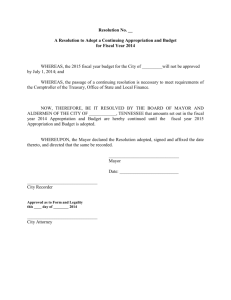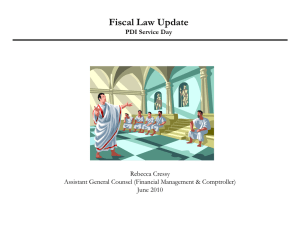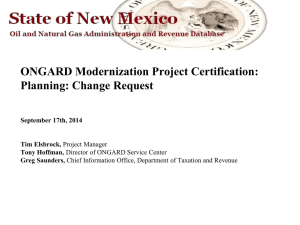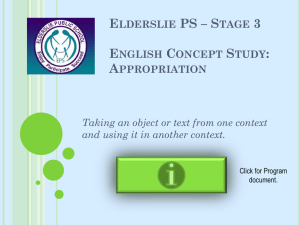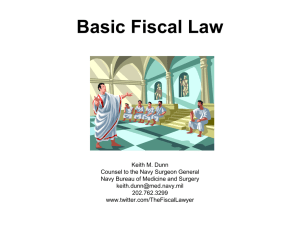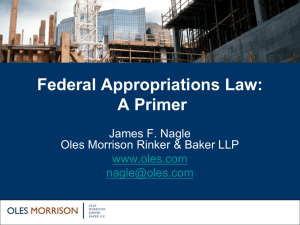Color of Money 11-10-09 - National Contract Management
advertisement
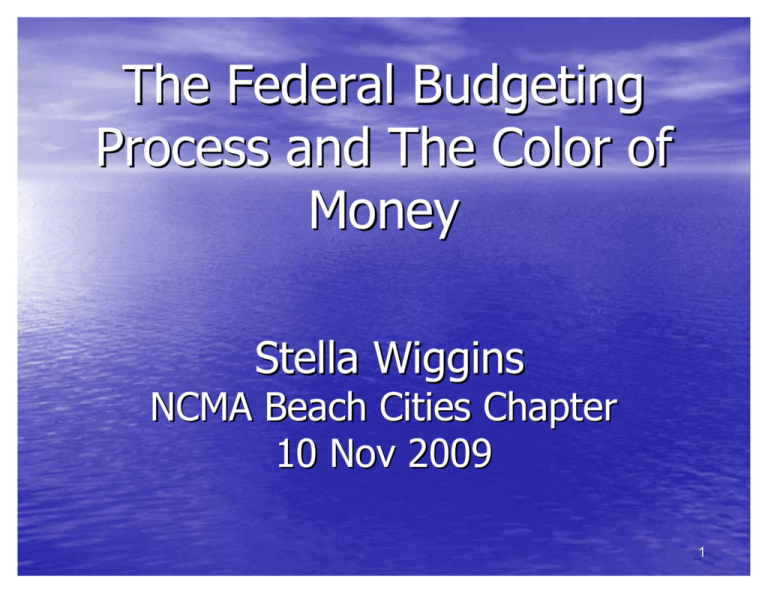
The Federal Budgeting Process and The Color of Money Stella Wiggins NCMA Beach Cities Chapter 10 Nov 2009 1 Agenda •Federal Budgeting Process History, Principles, Process •Appropriations – Definitions, Classifications, Codes, Life Cycles •ACRNS – Accounting Classification Reference Numbers 2 Federal Budgeting Process Background • Color of Money ¾ Purpose: Understand the various types of funding used by the U.S. Government to procure products and services from contractors ¾ Definitions: Various categories of funding or appropriations made available to the Government are commonly referred to as "Colors" of money to distinguish their unique purpose and usage. ¾ Fiscal law foundations: Legal ramifications inherent in this process. “Every fiscal year, Congress provides the Department of Defense with approximately 100 different appropriations or colors of money which are differentiated by branch of service, purpose and time..” 3 History & Process • History and Process: •The first general appropriation act, in 1789, appropriated $639,000. • With few statutory controls, there were windows for abuse, and in 1809 a resolution was introduced to prevent: ¾Diversion of public funds for uses outside purpose of the appropriation. ¾ Co-mingling of funds. ¾ Use of prior year funds for current year purposes. • Appropriations Clause “No money shall be drawn from the Treasury, but in consequence of appropriations made by law.” • Authority – Congress ¾ No money can be paid out of the Treasury unless it has been appropriated by an act of Congress ¾ A federal agency may not make a payment from the U.S. Treasury unless Congress has made the funds available 4 Fiscal Law Foundations • Executive Branch: ¾ Once the funds are appropriated by Congress, the Executive Branch agencies may then obligate or commit the funds for expenditure. ¾ Not always cooperative with what Congress has set as limits on expenditures • Fiscal Laws established to control the funding and payment process: ¾ Anti-Deficiency Act – Agencies may not spend, or commit themselves to spend, in advance of, or in excess of, appropriations. ¾ Bona Fide Need Statute • Appropriations may be used only for their intended purposes. Appropriations made for a definite period of time may be used only for expenses incurred during that time. • 5 Appropriations • Life Cycle of an Appropriation (Executive Branch) ¾ Long and exhaustive administrative process of budget preparation and review ¾ Primary participants in the process at this stage are the agencies and individual organizational units who review current operations, program objectives and future plans and the Office of Management and Budget (OMB) ¾ Throughout this preparation period, there is a continuous exchange of information among the various federal agencies, OMB and the President. ¾ The President’s budget is submitted to Congress on or before the first Monday in February of each year, for use during the following Fiscal Year (FY). 6 Appropriations (cont) • Life Cycle of an Appropriation (Congressional Action) • Appropriations are generally made in a series of regular appropriation acts plus one or more supplemental appropriations acts. • Following either the Senate passage of the House version of an appropriations measure, or the approval of a conference committee report, the bill is then sent to the President for signature or veto. • The Congressional Budget Act envisions completion of this process by October 1 of each year. 7 Appropriations (cont) • Budget Execution and Control Phase ¾ The period of time during which the budget authority made available by the appropriations acts remains available for obligation or commitment. “SPEND IT” ¾ Appropriated by Congress ¾ Apportioned by OMB ¾ Allocated by Department or Agency ¾ Committed by Program ¾ Obligated by Contracting Officer ¾ Expended by Payment Office 8 Appropriations (cont) • Obligating Appropriations • The statutory rule regarding obligations is that funds may be obligated only for the purposes for which they were appropriated. • Time - Monies should be obligated only to satisfy the bona fide need of the applicable fiscal year. • DoD uses their Planning, Programming, Budgeting, and Execution (PPBE) Process to budget and allocate funds. 9 Appropriation Expiration & Funding Availability • Appropriations Expiration – Time ¾ Funds may not be obligated in advance of an appropriation. ¾ An appropriation is available for payment of expenses properly incurred during the period of availability, or to complete contracts properly awarded during the period of availability. ¾ DoD agencies may obligate funds current at the time of award for severable service contracts with a period of performance that does not exceed one year. 10 Appropriation Expiration & Funding Availability (cont) – Government Funding Availability Definitions • Current appropriations - monies whose availability for new obligations has not yet expired under the terms of the governing appropriations act. • Expired appropriations - monies whose availability has expired for new obligations, but which are available to adjust and liquidate previous obligations. • Closed or Cancelled appropriations - monies that are no longer available for any purpose. • The time period for obligating funds differs depending on the type of appropriation; the expired period continues for five years after the obligation period, regardless of the appropriation. 11 Appropriation Expiration & Funding Availability • Classifications of Funds Based on Time ¾ One Year Appropriation - available for obligation only during a specific fiscal year. ¾ Multiple Year Appropriation - available for obligation for a definite period in excess of one fiscal year. ¾ No Year Appropriation - available for obligation for an indefinite period until it is expended. 12 Appropriation Expiration & Funding Availability (cont) • Classifications of Funds Based on Time Definite Appropriation - appropriation is a specific amount of money. • Indefinite Appropriation - appropriated by receipts from certain sources in amounts to be determined at a future date, or money for a specific purpose in sums as may be necessary. • Current Appropriation - money appropriated for the current fiscal year or immediately prior to the fiscal year. • Permanent Appropriation - standing account, which once made is always available without further action from Congress. • Unexpired Appropriation - available for incurring new obligations. • Expired Appropriation - unavailable for incurring new obligations, but available for disbursement. 13 Major DoD Appropriations • Procurement (Aircraft and Weapons) ¾ Used for production and modification of aircraft, missiles, weapons, vehicles, ammunition, shipbuilding and conversion. • Research-Development-Test and Evaluation (RDT&E) ¾ Used for expenses necessary for basic and applied scientific research, development, test and evaluation, including maintenance and operation of facilities and equipment. • Operations and Maintenance (O&M) ¾ Used for day to day expenses such as training exercises, deployments, civilian salaries, and operating and maintaining installations. 14 Major DoD Appropriations (cont) • Procurement - 3-year appropriation • Aircraft Procurement - fabricating, procuring, & modifying aircraft weapon systems • Missile Procurement - fabricating, procuring, & modifying missile systems to include RPVs and UAVs, • Other Procurement - vehicles, investment equipment, electronic / telecom equipment, other base maintenance and support equipment • Research, Development, Test and Evaluation - 2-year appropriation • basic & applied research, testing & evaluation • Operation and Maintenance - 1-year appropriation • day-to-day activities for bases 15 Major DoD Appropriations (cont) • Military Construction (MILCON) – 5-year appropriation • acquiring, installing, constructing, temporary/permanent public works for major construction inside and outside of the United States or military installations • Military Personnel (MILPERS) - 1-year appropriation • Family Housing – Two different categories. • One is 1-year appropriation. The other is 5-year appropriation 16 Major DoD Appropriation Codes Appropriation Procurement: Aircraft Missiles Weapons Ammunition Other RDT&E O&M Military Construction Military Personnel Reserve Personnel Stock Fund Army Navy Marin Air Force es 2031 2032 1506 2033 2034 1507 1508 2035 2040 1810 1319 2020 2050 1804 1205 1106 2010 2070 1453 1405 1105 1108 4991 4911 3010 3020 3011 3080 3600 3400 3300 3500 3700 4921 17 Funding Availability • Availability of the funds is determined by the type of expenditure for which the funds are appropriated • Procurement – 3 yr funds • Must be fully funded • RDT&E (research, development, testing & evaluation) – • 2 yr funds • May be incrementally funded • O&M (operation & maintenance) – 1 yr funds • May be incrementally funded 18 Funding Availability (cont) FY FY FY FY FY FY FY FY FY FY FY98/ 08 07 06 05 04 03 02 01 00 99 PRIOR Procurement A A A E E E E E X X X RDT&E A A E E E E E X X X X O&M A E E E E E X X X X X MILCON A A A A A E E E E E X A= ACTIVE E=EXPIRED X=CANCELLED 19 Funding Availability (cont) 20 Accounting Classification Citation, Example Using USAF Appropriation Codes FY08 O&M FUND CITATION 5783400 307 47E4 324301 040000 40900 72896F 672300 F7230H VA 57 8 3400 30 8 47 E4 324301 040000 40900 72896F 672300 7230H VA Department Fiscal Yr(2008) Appropriation (O&M) Fund Code (O&M) Fiscal Year (2008) Operating Agency Code (AFMC) Operating Budget Account Number (OBAN) (OC-ALC) Responsibility Center/Cost Center (RC/CC) Budget Activity Code (BAC) Element of Expense Investment Code (EEIC) Program Element Code (PEC) Accounting Disbursing Station Number (San Bernardino) DOD Activity Code ESP 21 Major DoD Appropriation Codes Appropriation Procurement: Aircraft Missiles Weapons Ammunition Other RDT&E O&M Military Construction Military Personnel Reserve Personnel Stock Fund Army Navy Marin Air Force es 2031 2032 1506 2033 2034 1507 1508 2035 2040 1810 1319 2020 2050 1804 1205 1106 2010 2070 1453 1405 1105 1108 4991 4911 3010 3020 3011 3080 3600 3400 3300 3500 3700 4921 22 Accounting Classification Reference Number (ACRN) • An ACRN is not a number, but a two letter designation for a • • • particular accounting classification citation. An ACRN may be applied to only one accounting classification citation in a given contract. If more than one accounting classification citation applies to a single line item, each ACRN, and associated funds, is identified in informational subline items. ACRNs are shown as : AA 5783400 307 47E4 324301 040000 40900 72896F 672300 F7230H VA ACRN: AA 23 Requirements Contract Administrators and the Government’s Color of Money Process… ¾ Contract Administrators must understand the Federal Budgeting Process (“color of money”), and be able to advise program personnel as necessary, particularly as it pertains to expiring or cancelling funds. 24 Questions & Answers Go to the DoD Financial Management Regulation (FMR). Go to Volume 2B, Chapter 5 for "color of money" definitions. The FMR can be accessed at http://www.dod.mil/comptroller/finman01.html 25
